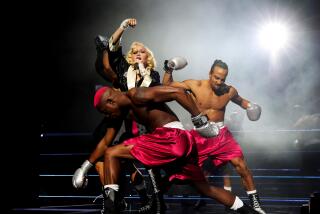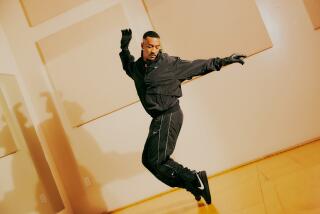Jamie King has got the moves
In a dark booth at the Polo Lounge, just down the street from his Beverly Hills home, tour director extraordinaire Jamie King struggles to recall the day he hung up his dance shoes for good. Though his management badly wants this interview to stay on the topic of his current feats as the director-writer of the Cirque du Soleil/Michael Jackson tribute world tour, “The Immortal” (Tuesday and Wednesday at the Honda Center and Friday through Jan. 29 at Staples Center), as well as his stint directing Madonna’s heat-seeking Super Bowl performance (Feb. 5), and please don’t forget the start of his Latin American “Idol”-esque TV series with Jennifer Lopez and Mark Anthony called “Q’Viva!” (premiering this month on Univision and later in spring on Fox), the affable King is giggling as he tries to remember exactly who was the last artist he danced for. He was neither injured nor burnt out at the time — he’d just become increasingly consumed with one-off choreographing and directing projects.
“Madonna!” he says, finally. “It was her. She wanted me to dance in her ‘Human Nature’ video. I didn’t want to do it, but she begged.” In the 1995 cult-favorite music video, a cat-suited Madonna sports a frisky S&M attitude in a realm of white-on-white boxes. King, then a spiky blond, hangs upside-down from a swinging trapeze in the scene, among other things.
A talk with King this month made Madonna’s pleas easy to understand. At 39, he is broad-shouldered and warm, with a soft Midwestern twang. It’s hard at first glance to reconcile this large, solid presence with his amazingly fast dance technique. Nor can one immediately see — as he gently cuts his pizza after a nonstop day of meetings on “Q’Viva!” — the stubborn, steely will that was needed to catapult him from dancer to choreographer to tour director by age 27.
Since 1999, he’s directed Ricky Martin (two tours), Rihanna (three), Britney Spears (three) and Christina Aguilera (two), among others. And don’t forget Madonna, whose last three stratospheric tours he conceived and directed. His trademark? Dream-like tours that feel born from the artist’s forehead, not his.
“If you can make it all — and that means the stage moves, the choreography, the costumes, the lighting — be a reflection of that artist, you’ve done your job correctly,” he says. “Because the fans will really understand the show.”
King prefers invisibility in his public life too. He keeps a low profile and has embarked on only one clunky self-promotional endeavor (a 2007 dance-exercise tape called “Rock Your Body” that’s proven too tricky for mass popularity). In the past, he’s acknowledged a relationship with the Beverly Hills Kabbalah Centre, where Madonna attends, but when asked if his close circle is made up of A-listers he’s fast to say, “No! I do that all day long!” Later, when he removes his dark sweater, a vintage Cartier key can be seen hanging from his neck. When prodded, he will say it was a special Christmas gift — but not from whom — and shyly demonstrate how its teeth spell L-O-V-E.
“Jamie has a spirit about him that is quite remarkable,” says “American Idol” founder Simon Fuller, King’s production partner on “Q’Viva!” “I need someone like him by my side.”
Especially now, by the sound of it. Fuller describes 200 far-flung contestants arriving in Los Angeles this month, to be winnowed to 60, who’ll then be coached in stage performance and presented in a concert, conceived and directed by King, in Las Vegas in late April, all played out on weekly television.
Fuller calls it “a massive, massive operation, which, with a [Lopez-Anthony] divorce in the mix, has become far-away the most complicated thing I’ve ever done.” On a happier note, it’s also the culmination of years of strategizing between Fuller and King to build a unique show around King’s artistic passions and directing talents.
“I recognize myself in those kids, those groups,” King says. He traveled to Argentine bars, festivals, dance studios and barrios during the taping. “I definitely see that hunger, just wanting to be heard, just wanting to be appreciated, just wanting someone to get you. I remember that. I still wake up like that.”
Born in Verona, Wis., to a white teenage mom and a black father who left when he was 5, King describes a people-pleasing childhood in which he felt the pain of his mother’s struggles and tried his best to ease the situation. “I learned to ‘produce’ early,” he says. By high school, he worked afternoons and weekends and summers: making pizzas, tinting car windows, cleaning offices, watering greenhouses.
At the same time, identifying powerfully with ‘80s pop stars (he rotated his outfits at school, “one week Michael, one week Prince”), King danced privately and obsessively. On a foundation of self-taught MTV video reenactments in his basement, King’s storybook public dance career took off at age 16 with a fast succession of school scholarships and contest wins, which led to a Los Angeles audition for Michael Jackson that landed him the single open slot for a male dancer on the 1992-93 “Dangerous” world tour. Within weeks, King was rehearsing Jackson’s tight, skidding moves from “Beat It” and head-bobbing syncopations from “Smooth Criminal” with the master himself.
King followed his curiosity, “absorbing everything.” After the 17-month Jackson tour, King was comfortable with and interested in all aspects of stage production. Working with musical directors, lighting and stage designers, wardrobe, jumbo screens, pyrotechnics, moving sets, he wanted to choreograph it all, and honed his craft working for Prince for several years. Then in 1999, garnering attention for his carnivalesque design for Ricky Martin’s Grammy Awards appearance, King was hired to direct the singer’s first U.S. tour. After Madonna caught Martin’s show one night, King explains, she asked him to help her launch her first tour after an eight-year hiatus. And the rest — disco-ball entrances, mechanical horses, roller-skate mania — is history.
“From when the lights go down, or when the lights come on, to when the screens open or the screens come up, and how that moves with the set pieces coming on or the dancers arriving, I see it all in a dance way,” King explains. He sips an iced tea between words. “One of my biggest dislikes is when those elements are not working together. I get very uncomfortable. I like it all to move and flow together and make sense, like theater.”
Cirque du Soleil spokesman Maxime Charbonneau says King’s background with rock tours and Jackson himself made him the easy choice to help the entertainment company in its first attempt to fill 10,000-seat arenas (and not wall off portions to retain intimacy). For King, who was used to working so incisively as to move from a shoe box concept to world tour in several months, Cirque’s initial open-ended creative period was unsettling. “They like to just throw things at you left and right and see what you respond to,” King explains. “They say it’s ‘feeding’ — they like to ‘feed’ you and wait while you chew on it.”
Using 65 songs, 30 dancers, 25 acrobats, 10 musicians and a 10-choreographer team, King conceived and directed “The Immortal” to center on a place (Neverland Ranch, which he visited early on) rather than his usual artist-focused orientation. Jackson is represented by master tracks of his singing voice, video and spoken-word clips and amplified representations of his most identifiable choreography and accessories.
Since the show opened in Las Vegas in December, reviewers have paled at some cartoonish mash-ups and missteps during pivotal songs (e.g. a frolicking life-size sequined glove and loafers during “Beat It”), yet there’s been no argument over King’s ability to intensify and amplify the precise, essential dance power in such signature numbers as “Billie Jean” and “Thriller.”
Next month, even more of King’s oversize movement collaborations with Cirque du Soleil performers and crew will be visible during Madonna’s high-exposure Super Bowl performance. “There’ll be some magic,” he says slyly.
Meanwhile, as the “Immortal” tsunami rolls into Los Angeles this month (more than 900,000 tickets have sold in North America), King has officially begun work with Cirque on the more intimate, permanent version of “The Immortal” to go up in Vegas in 2013.
It had been his “great dream,” he says, to scale back to create a work for a fixed site. “The possibilities are just endless when you’re in a theater and there aren’t people standing in front of you like in a rock concert, with popcorn flying and alcohol,” he says. “This will be a focused environment where we’ll really have people’s attention. I just can’t wait.”
More to Read
The biggest entertainment stories
Get our big stories about Hollywood, film, television, music, arts, culture and more right in your inbox as soon as they publish.
You may occasionally receive promotional content from the Los Angeles Times.






